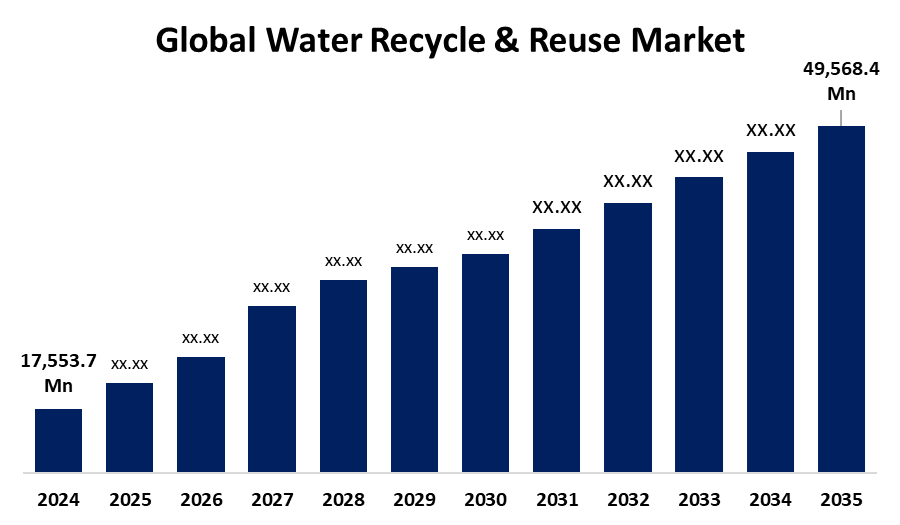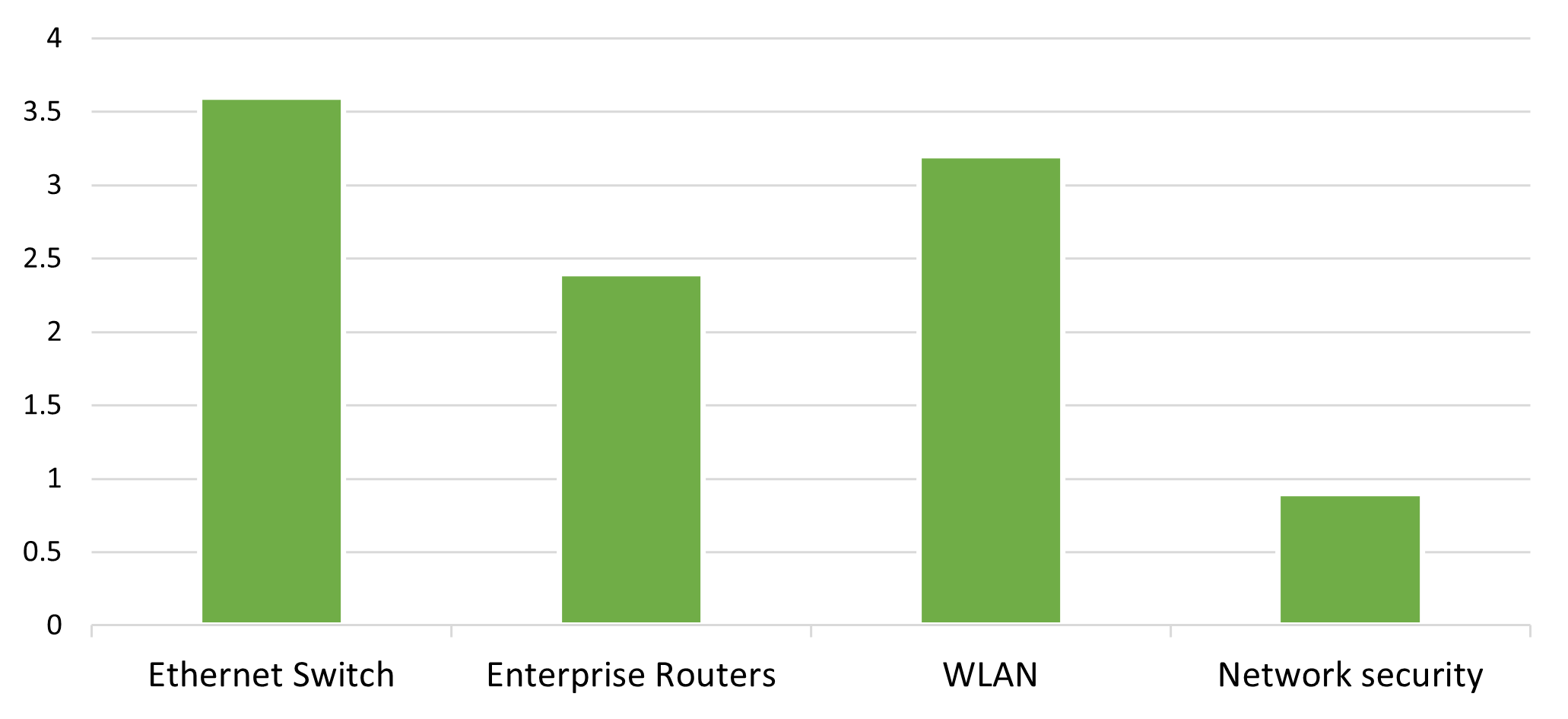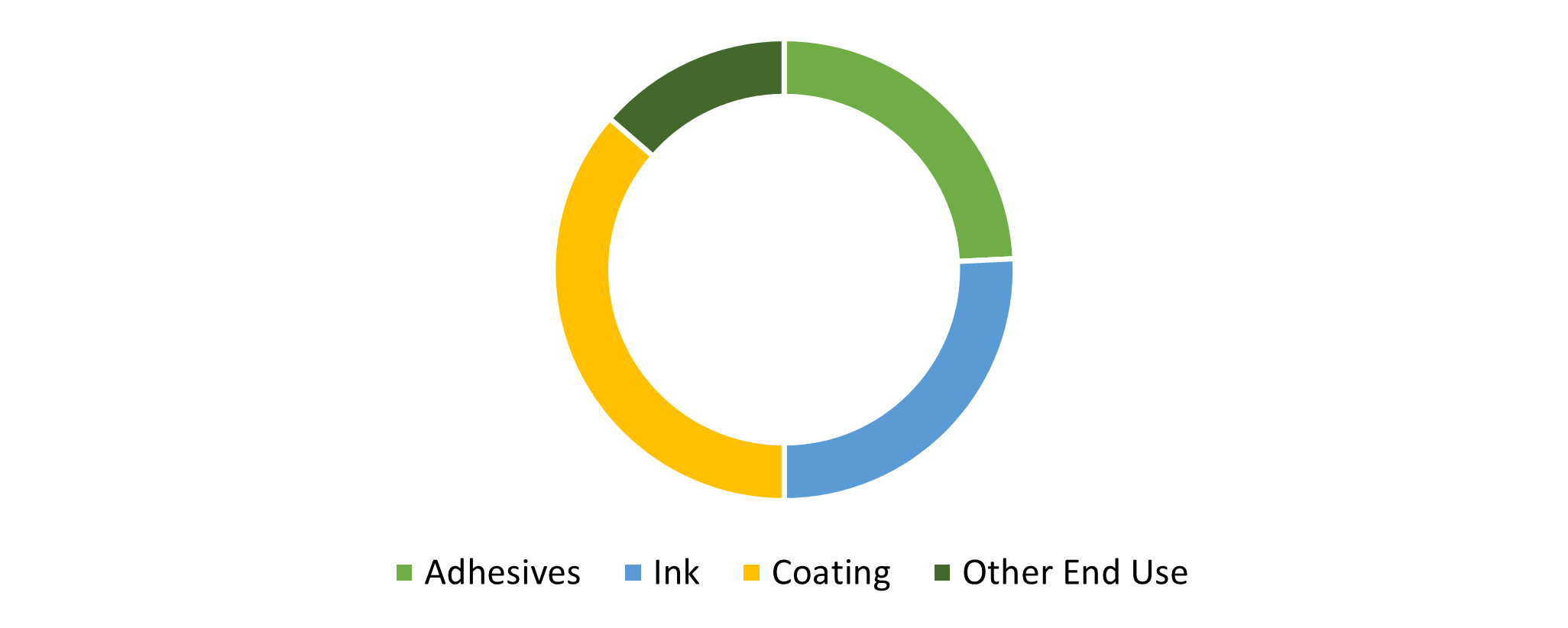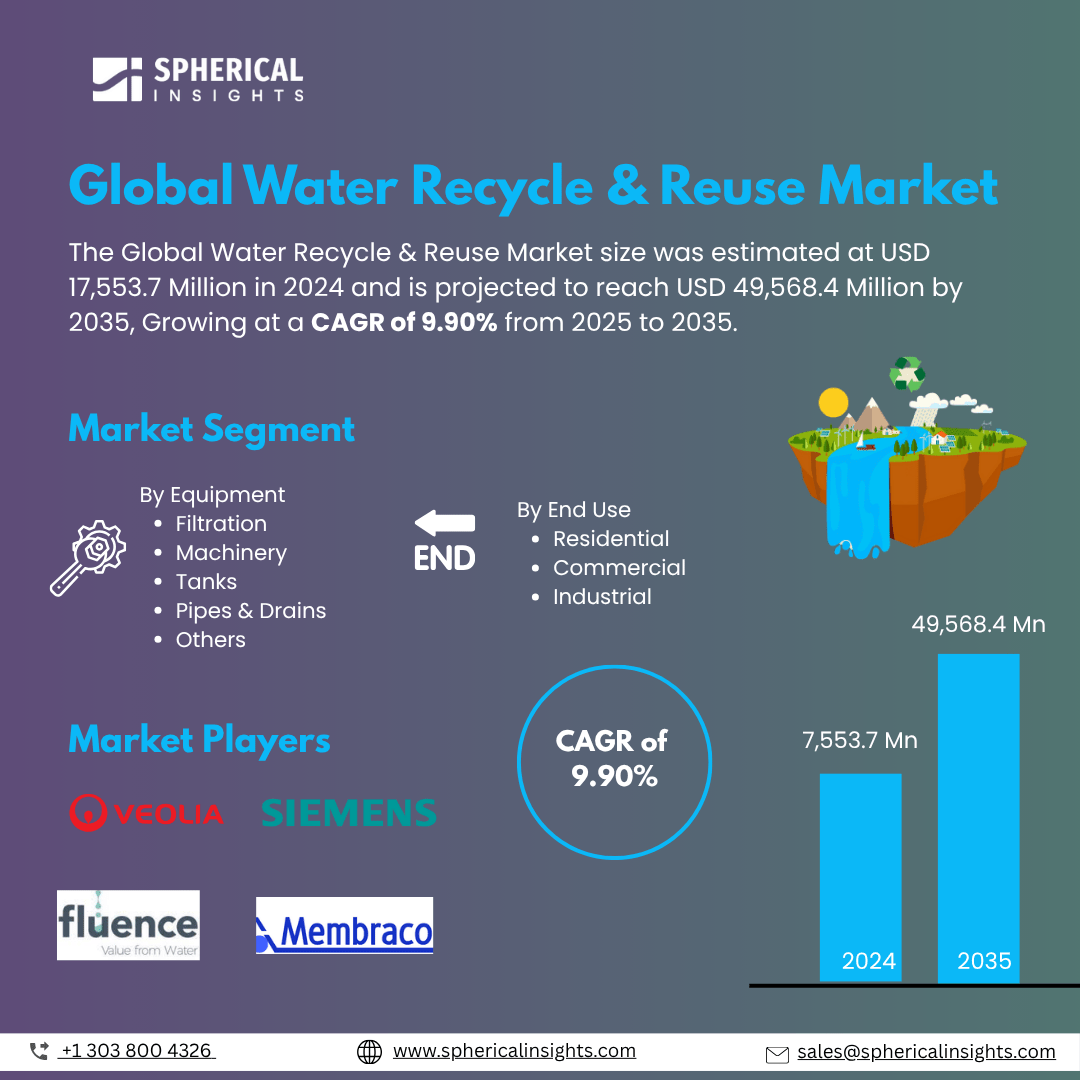Water Recycle & Reuse Market Summary
The Global Water Recycle & Reuse Market size was Estimated at USD 17,553.7 Million in 2024 and is projected to Reach USD 49,568.4 Million by 2035, Growing at a CAGR of 9.90% from 2025 to 2035. The market for water recycle and reuse is expanding quickly as a result of increased environmental concerns, water scarcity, and the requirement for sustainable water management.
Key Regional and Segment-Wise Insights
- In 2024, the Asia Pacific water recycle & reuse market held the largest revenue share of 35.4% and led the global market.
- In 2024, filtration held the largest revenue share of 34.5% and led the market based on equipment.
- Industrial use dominated the market and generated the highest revenue share of 47.7% in 2024 based on end use.
Global Market Forecast and Revenue Outlook
- 2024 Market Size: USD 17,553.7 Million
- 2035 Projected Market Size: USD 49,568.4 Million
- CAGR (2025-2035): 9.90%
- Asia Pacific: Largest market in 2024

The water recycle and reuse market includes the methods, services, and products used to manage and reuse stormwater, wastewater, and other non-potable water sources for various purposes. The available market growth is due to a combination of factors, including increasing water scarcity, the need for sustainable water management solutions, and new or revised government regulations promoting water conservation and reducing environmental impact. Another primary driver for growth is increasing requirements for various methods to effectively recycle and reuse water to treat wastewater generated by people and commercial and industrial service providers while conducting potable and non-potable uses, such as industrial processes, irrigation for agricultural activities, and toilet flushing. With more government and municipal mandates for water recycle and reuse systems in the industries and urban centres, there is increasing demand for new water treatment technology and infrastructure development.
As the world's population continues to grow, industrialization increases, and climate change worsens drought situations, traditional water sources are rapidly diminishing. This difficult circumstance has led to a paradigm shift toward sustainable water management practices, specifically in the area of water recycle and reuse. Technological advancements heavily influence the water recycle and reuse industry. Advancements in membrane filtration, reverse osmosis, UV disinfection, and smart water management systems are all enhancing water quality, efficiency, and operational costs. In addition to technological advancements, the increasing demand for recycled water for surface storage reservoirs and groundwater aquifers, and the emergence of economic technologies to detect contaminants and monitor water quality also support the market's growth. Furthermore, the market is expanding favorably due to the widespread use of recycled water in paper mills, concrete mixing, artificial lakes, and various building applications.
Equipment Insights

In 2024, the filtering segment of this market represented 34.5% of the global revenue share, surpassing the other segments. Filtration technologies are important to remove contaminants, impurities, and particles from wastewater to meet the required quality for different applications. Filtration technologies like reverse osmosis, ultrafiltration, and nanofiltration are commonly utilized in water recycle and reuse applications because of their high performance, efficacy, and ability to remove a wide variety of contaminants from water. These filtration technologies utilize semi-permeable membranes to separate and remove particles, contaminants, and microbes from water to provide high-quality treated water. The driving demand in this market is the increasing use of filtration technologies in municipal and industrial water treatment implementations.
An increasing demand for decentralized water storage solutions is likely to drive the significant growth of the tanks segment during the forecast period. Tanks are critical storage units containing treated and untreated water for various applications, such as industrial reuse and agricultural irrigation. The increasing focus on sustainable water management practices, such as rainwater harvesting, is also increasing the demand for storage tanks. Governments and businesses are investing in infrastructure to enable effective water conservation and reuse. As water scarcity continues to be a leading global concern, reliable storage solutions like tanks are becoming increasingly vital.
End Use Insights

In 2024, the industrial end-use sector held 47.7% of global sales and was the biggest sector in the market. For many industrial processes, large volumes of water are typically used in a range of activities in manufacturing, processing, cooling, and cleaning. Industrial processes, therefore, depend on large volumes of water resources, and they discharge large volumes of effluent that may be recycled and reused. Adoption of water recycle and reuse systems is also being driven by industries' commitment to reducing their water footprint and complying with environmental regulations. Implementation of recycle and reuse systems can offer significant cost savings to businesses by reducing costs associated with fresh water procurement, wastewater treatment, and improved operational efficiencies. In some cases, industrial processes require specialized treatment systems to meet stringent water quality requirements.
The rise in water recycle systems installed in hotels, hospitals, office buildings, and educational campuses will boost the growth of the commercial segment in the upcoming years. Two major factors driving acceptance include the necessity to conserve water and a growing consciousness towards sustainable practices. Additionally, governments play a key role in promoting water recycle systems through subsidies and regulations. Eco-friendly infrastructure is increasingly important to businesses, both to reduce operating expenses and to comply with environmental rules and regulations. This trend should help propel the market participants' growth over the forecast period.
Regional Insights
The water recycle and reuse sector in North America is being affected by increasing concerns regarding water scarcity and environmental sustainability. Supportive legislative frameworks and increased public awareness are promoting the acceptance of smart and decentralized water reuse technologies. Companies, along with municipalities, are using advanced treatment technology to be less dependent on freshwater sources, while driving water conservation. The market for water recycle and reuse has grown due to new advanced treatment technologies and strong regulatory frameworks.
U.S. Water Recycle & Reuse Market Trends
The U.S. water recycle and reuse market is anticipated to grow at a CAGR of 8.4% between 2025 and 2035. Supporting this growth are active state-level programs and comprehensive environmental regulations, which help promote sustainability in water management. Also, the United States has an active water reuse market due to rules governing environmental protections, sustainability tracking, water stress, and other variables. States, especially California, Texas, and Florida, which are facing water stress with high demand, have now put several building blocks in place to recycle and reuse water for groundwater replenishment, industrial processes, landscape irrigation, and agriculture.
Europe Water Recycle & Reuse Market Trends
The water reuse and recycle industry in Europe is driven by regulatory requirements, circular economy goals, and climate resilience initiatives. To address the lack of water, especially in drought-prone areas, countries including Spain, Italy, and Cyprus are implementing water reuse programs. The region is utilizing advanced treatment technology to promote water reuse for urban, industrial, and agricultural use. The European Union's Water Framework Directive and the laws of other states encourage water reuse and the adoption of water-efficient measures by cities, municipalities, and businesses. Furthermore, with a strong focus on stormwater reuse and decentralized urban water management, the water recycle and reuse sector in Germany is supported by technology developments and intelligent monitoring systems. Climate variation and increased urban water demand in the UK are driving the sector, with an emphasis on infrastructure improvements and treated wastewater for non-potable uses.
Asia Pacific Water Recycle & Reuse Market Trends
Asia Pacific water recycle & reuse industry dominated and accounted for 35.4% of the global share in 2024. The Asia Pacific region is undergoing rapid urbanization and industrialization, leading to a rise in water demand and wastewater production. As urban populations increase, the pressure on water resources increases, making the need for sustainable management practices such as water recycle and reuse necessary. Governments across the region are currently investing in water infrastructure as well as decreasing water use in industries through closed-loop water systems. Technological adoption is accelerating towards a more advanced technology for the water sector. In some cases, this trend is emphasized as lower-cost and scalable solutions for various local needs. Countries across the Asia Pacific are investing in R&D to improve membrane filtration, biological treatment, and other water treatment technologies. While it is some parts of the Asia Pacific have considerable water resources, the region still faces enormous water scarcity challenges in many densely populated urban centers and drought-prone regions.
Key Water Recycle & Reuse Companies:
The following are the leading companies in the water recycle & reuse market. These companies collectively hold the largest market share and dictate industry trends.
- Veolia
- Fluence Corporation Limited
- Siemens
- Membracon
- Dow Corporate
- Hitachi Ltd.
- Evoqua Technologies & Solutions
- Hydraloop
- Kubota Corporation
- Toshiba Infrastructure Systems & Solutions Corporation
- Alfa Laval
- Genesis Water Technologies Inc.
- NEWater China
- Others
Recent Developments
- In February 2025, in Texas, El Paso Water began construction on the Pure Water Center, the first direct-to-distribution potable reuse facility in the country. The project will treat secondary effluent from the Roberto R. Bustamante Wastewater Treatment Plant to generate up to 10 million gallons of high-quality purified water per day. It is scheduled to be constructed by a joint venture between PCL and Sundt Construction. The project is now under construction and should be operational by 2028.
- In March 2022, Kao Corporation and WOTA Corp. have entered into a fundamental agreement to create a corporate partnership to address societal needs of water and sanitation. To formalize this partnership, Kao made an investment in WOTA. They will seek all opportunities to leverage our individual technologies and knowledge and jointly create a sustainable, small-scale, decentralized water reuse society.
Market Segment
This study forecasts revenue at global, regional, and country levels from 2020 to 2035. Spherical Insights has segmented the water recycle & reuse market based on the below-mentioned segments:
Global Water Recycle & Reuse Market, By Equipment
- Filtration
- Machinery
- Tanks
- Pipes & Drains
- Others
Global Water Recycle & Reuse Market, By End Use
Global Water Recycle & Reuse Market, By Regional Analysis
- North America
- Europe
- Germany
- UK
- France
- Italy
- Spain
- Russia
- Rest of Europe
- Asia Pacific
- China
- Japan
- India
- South Korea
- Australia
- Rest of Asia Pacific
- South America
- Brazil
- Argentina
- Rest of South America
- Middle East & Africa
- UAE
- Saudi Arabia
- Qatar
- South Africa
- Rest of the Middle East & Africa






